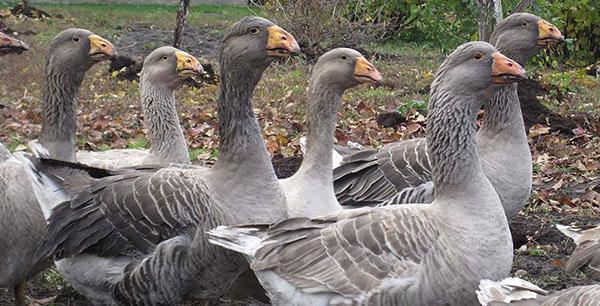Choosing for ourselves geese of the Tula breed
 Geese are the second largest group of poultry. There are more than 3,000 breeds of this bird in the world. All breeds are divided:
Geese are the second largest group of poultry. There are more than 3,000 breeds of this bird in the world. All breeds are divided:
- downy;
- meat;
- fatty.
Downy breeds are grown to produce goose down. It is used to make a filler for jackets, pillows and blankets.
Goose fat, obtained from fatty breeds, is one of the most valuable medicines used for frostbite. In addition, fatty geese are raised to produce a large liver.
Meat geese grow up to 14 kg of live weight. The largest are the birds of the "Tula" breed. In the southern regions of Russia it is called the "Fighting" breed.
The history of the "Fighting" breed
The largest "Fighting" breed of geese is considered the oldest. She was bred in 1814 for sports purposes in the city of Tula. Tula merchants and wealthy townspeople regularly staged bird fights with bets. As a rule, wild birds won, namely the gray geese.
With the development of breeding, it became possible to artificially cross the gray goose and the dry-nosed goose - a goose with a fighting disposition. A new breed was bred, which was named "Fighting".
Subspecies of "Tula" breed
As a result of artificial selection, three subspecies of the "Tula" breed of geese appeared:
- "Straight-nosed";
- "Hump-nosed";
- "False noses".
The straight-nosed Tula geese inherited from their ancestors a bad fighting disposition. There are fights among these geese every day. With the help of fights, birds win their place in the hierarchy, so there are very few deaths. The battle lasts until one of the opponents is subdued. As a rule, males become the leaders of straight-nosed fighting geese.
For this subspecies, it is better to build a separate enclosure and limit their grazing area from other breeds. Geese fiercely defend their territory and can kill smaller birds.
Hump-nosed geese are a peaceful subspecies of the "Tula" breed. You can distinguish them by the characteristic hump on the beak. These geese also fight for a place in the hierarchy, but do not conflict with other birds.
The color of the feathers of the hump-nosed Tula gosling is dark yellow, with a greenish tint. The beak is dark green with a bump on the bridge of the nose, the eyes are black. These goslings gain the most weight, therefore they are considered a meat subspecies of the "Tula" breed.
False-nosed geese are bred mainly because of the fluff. They can be distinguished by the characteristic growth on the beak, similar to three cones that have grown together. This subspecies has powerful flight wings, so it flies long distances in search of a reservoir.
The meat of this subspecies is tough, but the geese have the highest egg production among the "Tula". Goose eggs are great for making dough.